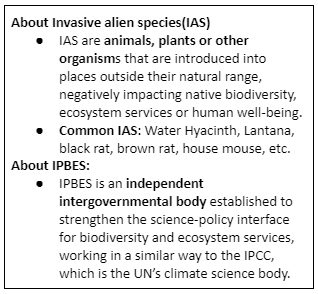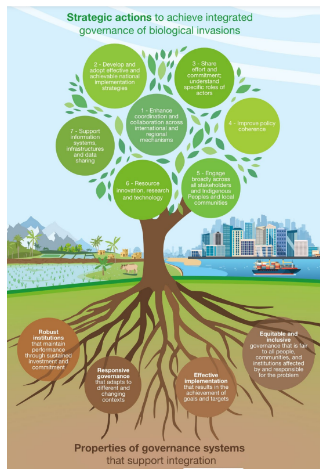
Context:
- Recently, a report on the status of invasive alien species (IAS) was released at 10th plenary of the Intergovernmental Science-Policy Platform on Biodiversity and Ecosystem Services (IPBES).
Highlights of the Report:
- Anthropogenic introduction of IAS: 37,000 alien species have been introduced by human activities to regions and biomes around the world.
- Many IAS have been intentionally introduced for their perceived benefits, without consideration or knowledge of their negative impacts.
- Threat to biodiversity: IAS are one of the five major direct drivers of biodiversity loss globally, alongside land and sea use change, direct exploitation of organisms, climate change, and pollution.
 IAS have been a major factor in 60% and the only driver in 16% of global animal and plant extinctions that have been recorded, and at least 218 invasive alien species have been responsible for more than 1,200 local extinctions.
IAS have been a major factor in 60% and the only driver in 16% of global animal and plant extinctions that have been recorded, and at least 218 invasive alien species have been responsible for more than 1,200 local extinctions.
- Economic cost: It has at least quadrupled every decade since 1970, as global trade and human travel increased.
- In 2019, the global economic cost of invasive alien species exceeded $423 billion annually.
- Impact on food supply: The reduction of food supply is the most common impact of alien invasive species.
- Caribbean false mussels have damaged locally important fishery resources in Kerala, by wiping out native clams and oysters.
- Spread of diseases: IAS like Aedes albopictus and Aedes aegyptii spread diseases such as malaria, Zika and West Nile Fever.
- Amplifying the impact of climate change: Invasive alien plants, especially trees and grasses, can sometimes be highly flammable and promote more intense fires.
- IAS can reduce the resilience of natural habit, agricultural systems and urban areas to climate change.
- Geographical Impact: 34% of the impacts of biological invasions were reported from the Americas, 31% from Europe and Central Asia, 25% from Asia and the Pacific and about 7% from Africa.
- Threat concentration: Most negative impacts are reported on land (about 75%) with considerably fewer reported in freshwater (14%) and marine (10%) habitats .
- Invasive alien species are most damaging on islands, with numbers of alien plants now exceeding the number of native plants on more than 25% of all islands.
- Threat management: Only 17 percent have enacted specific national laws or regulations for IAS management.
- 45 percent of all countries do not invest in the management of IAS. It escalates the threat of IAS spilling over into neighboring states.
Significance:
- Impact assessment: It will help improve the understanding of IAS, their impacts, and opportunities for their management across all sectors of society.
- Action plan under KMGBF: The assessment can be used for updating the national biodiversity strategies and action plans (NBSAPs) mandated under Kunming-Montreal Global Biodiversity Framework (KMGBF).
Kunming-Montreal Global Biodiversity Framework (KMGBF):
- Parties to the Convention on Biological Diversity (CBD) adopted the KMGBF during the fifteenth Conference of Parties (COP-15).
- The framework is made up of 4 global 2050 goals and 23 global 2030 targets.
- This includes, biodiversity conservation and restoration, nature’s contribution to people, access and benefit sharing and tools and solutions for mainstreaming and implementation.
- Under it, the world has to prevent and reduce the rate of introduction and establishment of IAS by at least 50 per cent by 2030.
|
- Coordinated Actions: It will support countries and the private sector in developing and implementing actions towards meeting the targets under KMGBF.
Current Regulatory Framework for management of IAS in India:
- National Biodiversity Action Plan: It set out the National Biodiversity Targets which aims to develop management strategies for IAS.
- Plant Quarantine (Regulation of Import into India) Order 2003: Under this, any import of plants or seeds into the country should be inspected for the potential risk of pests.
- Wildlife (Protection) Amendment (WPA) Bill 2021: It provides for a regulatory framework for IAS in the Indian environmental legislative regime.
|
Impact of IAS on India:
- India stands in second place after the US on the list of invasion-cost bearing countries.
- Invasive alien species cost the Indian economy $127.3 billion (Rs. 8.3 trillion) in the last 6 decades.
- IAS cost the Indian economy $127.3 billion in the last 60 years.
- Lantana camara: Its invasion has resulted in the scarcity of native forage plants for wild herbivores; it has invaded more than 40% of India’s tiger range.
- Prosopis Chilensis: A drought-resistant plant native to the arid regions of South American countries is threatening native vegetation of islands in the Gulf of Mannar Biosphere Reserve.
- Prosopis juliflora: It is a water-guzzling invasive species which extracts maximum water from the ground impacting the groundwater levels adversely affecting local biodiversity and ecology.
Important Recommendation from the Report
- Incorporating IAS in Climate change policies: Climate change should be explicitly incorporated into risk assessments of IAS, to help identify those alien species that could become a threat in the future.
- Example: Native tree species should be used for carbon sequestration or erosion control rather than alien species such as Acacia or Eucalyptus.
 Mapping vulnerability: Ecosystems need to be prioritised according to their vulnerability to climate change and IAS and measures need to be established for preventing IAS introduction.
Mapping vulnerability: Ecosystems need to be prioritised according to their vulnerability to climate change and IAS and measures need to be established for preventing IAS introduction. - Prevention measures: Border biosecurity and strictly enforced import controls has worked in controlling the spread.
- Example: Success has been achieved in Australasia in reducing the spread of the brown marmorated stink bug.
- Protecting marine and connected water systems: Preparedness, early detection and rapid response are shown to be effective at reducing rates of alien species establishment.
- Surveillance of new alien species: The PlantwisePlus programme in Australia assisted smallholder farmers in Africa, Asia and Latin America in detecting new alien species.
- Eradication: It has been successful and cost-effective for small and slow-spreading IAS, in isolated ecosystems such as islands.
- Examples: French Polynesia where the black rat and rabbit(have been successfully eradicated.
- Containment: IAS must be contained and controlled in land-based and closed water systems as well as in aquaculture.
- Containment of the IAS Asian tunicate in aqua-cultured blue mussels in Canada.
- Introducing a rust fungus to control bitter vine in the Asia-Pacific region has been effective with success in more than 60% of known cases.
- Involvement of local communities: Successful eradication programmes depend on the support and engagement of stakeholders and Indigenous Peoples and local communities.
News Source: Indian Express
![]() 5 Sep 2023
5 Sep 2023

 IAS have been a major factor in 60% and the only driver in 16% of global animal and plant extinctions that have been recorded, and at least 218 invasive alien species have been responsible for more than 1,200 local extinctions.
IAS have been a major factor in 60% and the only driver in 16% of global animal and plant extinctions that have been recorded, and at least 218 invasive alien species have been responsible for more than 1,200 local extinctions. Mapping vulnerability: Ecosystems need to be prioritised according to their vulnerability to climate change and IAS and measures need to be established for preventing IAS introduction.
Mapping vulnerability: Ecosystems need to be prioritised according to their vulnerability to climate change and IAS and measures need to be established for preventing IAS introduction.